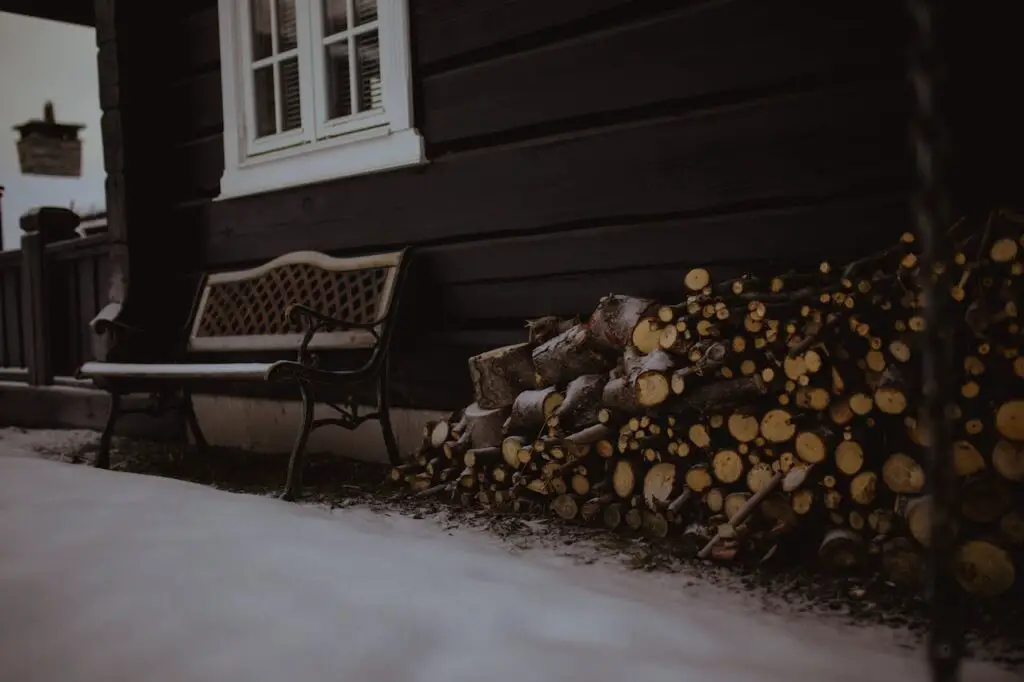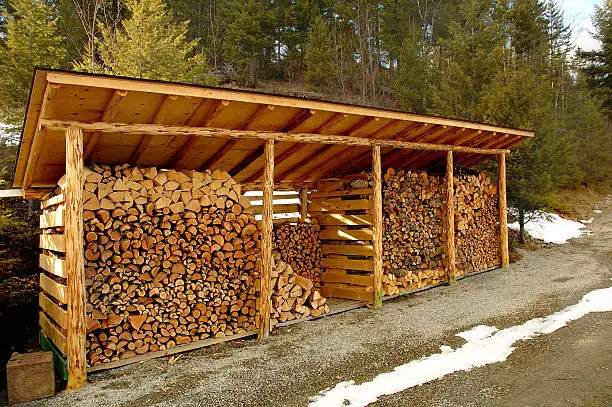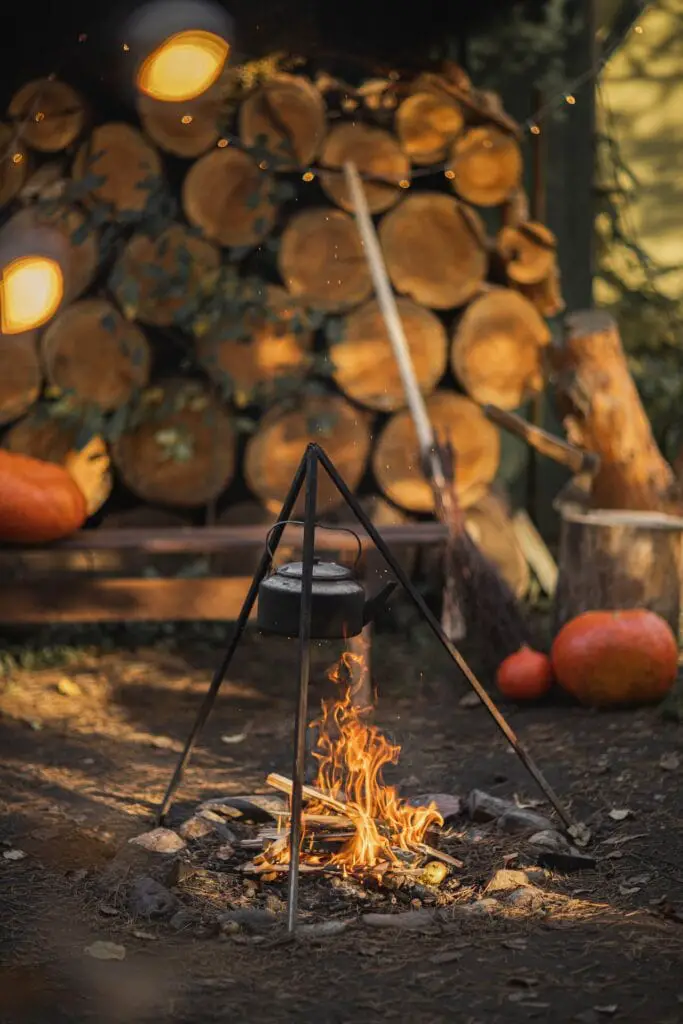If you buy firewood by the cord (or by the half cord or quarter cord, depending on your wants), you will need firewood storage. For those who are unfamiliar with the process, storing firewood may seem like a straightforward task that just needs a storage rack and some consideration, but the location and method of storing your firewood have a greater impact than most people realize.
Poorly positioned or improperly piled firewood heaps are more prone to develop problems, such as mold, fungus, or wood that burns poorly. Additionally, they are more likely to be home to animals like snakes or rodents, which poses further risks to public safety.
Of course, no amount of careful stacking will ensure that mold, mice, or snakes never appear in your stack, but there are a few easy actions you can take to keep your woodpile as dry, clean, and secure as possible. In light of this, the following seven firewood storage pointers will assist you in a proper firewood storage method.
7 Ways on How to Store Firewood Properly
The right storage technique must be used while storing firewood to safeguard your hardwood and financial commitment. Below are some stacking firewood methods you should know.
Firewood Should only be Kept Indoors After being Kiln-dried.

Essentially, you have two choices when it comes to storing your firewood: inside or outside. The kind of firewood you have will determine which choice is best for you. Firewood comes in three basic varieties: green, seasoned, and kiln-dried. The following are each’s basic definitions:
- Green Firewood: freshly chopped but not yet given time to dry (wet wood)
- Seasoned Firewood: at least six months of air drying to remove moisture
- Kiln-Dried Firewood: Dried for 36 hours at 265°F in a kiln to remove all invasive pests and lower the moisture level to less than 20%
Because green and seasoned firewood frequently contains mold, fungi, insects, and chemicals, it is not safe to store them indoors. We don’t want any of those spooky creatures in our home. Kiln-dried firewood, on the other hand, is not affected by this issue. The wood is safe to store indoors since the extremely hot kiln eliminates any invasive bugs that might have been hiding in the wood.
Additionally, for additional air drying, both green and seasoned wood require outside storage. There is still a lot of moisture in green firewood to release. Furthermore, even when seasoned wood has previously been air-dried for several months, this is rarely sufficient to achieve the necessary level of dryness. Instead, for best burning performance, seasoned wood is typically still much above the 20% dryness criterion.
Kiln-dried firewood, on the other hand, undergoes a carefully regulated drying process that consistently lowers its moisture content to less than 20%. Therefore, you can always rely on kiln-dried wood to burn hotter, longer, and cleaner. Furthermore, you won’t need to bother about doing additional outside air drying. Since it’s already as dry as it needs to be, controlled indoor conditions will be ideal for it.
Properly Stack Your Firewood for Maximum Airflow
The location of your firewood storage is not as crucial as how you stack it. This is because incorrect stacking may obstruct airflow, resulting in wet and moldy components.
By stacking the wood in a row with at least two feet of space between each piece and all of the pieces facing the same direction, you can avoid this. Avoid packing the parts too closely together. Rather, create tiny spaces between the parts to allow air to pass through and keep them dry.
The pieces of wood should be stacked bark-side down when stacking green or seasoned wood outdoors. As the wood dries, this will make it easier for the water to evaporate out of it. Additionally, since the seasoned wood is what you’ll want to burn first, it makes sense to stack it with the greener wood at the bottom and the more seasoned wood at the top.
On the other hand, since kiln-dried firewood doesn’t need to dry further, you can stack it with the bark facing up. When storing wood outside, it can be shielded from the possibility of water intrusion by being laid with the bark facing upwards.
Keep Your Wood Dry
Because the cut ends of wood allow the majority of its moisture to escape, storing wood with its cut ends exposed is essential to keeping it dry. Regardless of the stacking pattern you choose or the container you use to store your wood, this is something to be aware of. Since most firewood stacks are made in a single row, you may ensure that the cut ends are visible by arranging each piece so that it faces both the front and the back of the stack.
The direction your cut ends face may change if you employ one of the stacking techniques that involves positioning each layer to maximize airflow in a different direction. Although it could be tempting to stack your wood loosely to enable more air to circulate between the logs, avoid the impulse to pack your wood as firmly as you can to conserve room.
It would be best if you also were mindful of the orientation in which you stack each piece of split firewood, which has bark on only one side. For instance, arrange your wood so that the bark side is facing the ground if you are stacking it on the ground and you are worried about the soil being overly wet. If your wood is still a little green and needs more time to dry, you should stack it with the bark side facing the earth.
By stacking your dry wood with the bark facing up, which will more easily allow the rain and snow to roll off of the wood, you can help protect it from the elements if your stack isn’t covered.
Allow Firewood to Breathe Outside
Firewood, both green and seasoned, must be stored outdoors. It is safe to store firewood that has been kiln-dried indoors or outdoors. Now that we know all three kinds of wood are suitable for outdoor storage, let’s talk about how to store firewood outside.
Giving the firewood enough room is the most crucial factor to take into account when deciding where to store it outside. All kinds of firewood require space to be shielded from moisture and insects that could feed on the wood when used outside. Space allows seasoned and green firewood to air dry peacefully. Space keeps kiln-dried firewood in perfect burning condition. How, then, do you allow space for your firewood? Two approaches:
- Make sure the timber is kept off the ground.
- Keep your wood pile away from other buildings and your house.
Avoid Piling Firewood Up against Your Home

Many individuals keep firewood stacked up against their homes for storage. The logs are kept close at hand in this handy place. The eaves also aid in shielding your wood from snow and rain. Although there are valid reasons to position your firewood storage close to your home, doing so is generally not a good idea.
The main reason to avoid stacking wood on your house is that it is extremely explosive and can quickly catch fire from stray sparks from a wildfire, your fire pit, your barbeque grill, your illusion, or your patio fireplace.
Another concern is giving animals a place to live close to windows or doors that lead into your house. Having a friendly habitat thus close to entryways encourages vermin, snakes, and rats to live right outside your windows or doors. Firewood stack facilitates their entry into your house and increases the likelihood that they may cause problems for you, your children, or your pets when they come and go. Furthermore, placing objects up against your house can provide mice and rats with a home or a route, which may cause rodent problems or make already existing ones worse.
As usual, we also need to worry about the wood remaining dry. Storing wood up against a wall restricts air movement. This makes it more likely that your woodpile will retain moisture, which can breed mold or fungus and slow down the drying process for green wood. If you do stack your firewood close to a wall or fence, make sure there is enough space between the wood and the structure to allow for airflow—at least a few inches.
Use a Firewood Rack

Using a firewood rack is the most practical and straightforward method of storing firewood. Firewood racks are widely available, typically reasonably priced, and can be customized to your specifications in terms of size and design. They make it easier to stack firewood without having to give it much consideration, and they are useful for keeping your wood off the ground and organized.
By constructing a foundation that keeps your pile off the ground and driving stakes into the ground to stabilize the sides of your pile, you can also construct a DIY firewood rack. When it’s going to rain or snow, you can cover your firewood pile with a tarp or construct a cover for it.
If you place your woodpile on a covered patio or beneath a shed’s eaves, there might already be pillars or columns there that can hold the stack’s sides.
Keep Your Firewood Storage Area Clean
The majority of people don’t give their firewood stack much thought, especially in the warmer months when they burn wood less frequently. This is regrettable since an ignored wood stack can grow extremely ugly, detract from the look of your yard as a whole, attract vermin, raise the risk of a fire, and develop moisture problems.
Letting weeds or grass grow around your woodpile is one example. The primary issue with this is that it lessens the vital airflow beneath and around the base of your pile. The likelihood that moisture will remain in the region and impact your wood is further increased if you allow weeds or neighboring plants to develop around your wood stack. Furthermore, plants surrounding your firewood storage shed give cover to animals that are more likely to utilize the space as a home or a hiding place while they explore your yard. Unchecked grass or weed growth also detracts from the overall aesthetic appeal of your yard by making your firewood stack appear messy.
Conclusion
Understanding the nuances of storing firewood is not just a practical necessity but a journey toward ensuring the warmth and efficiency of your fireplace or wood-burning stove. By adhering to the tips and techniques outlined in this guide, you’re not only safeguarding your firewood from the elements but also enhancing its combustion potential. Remember, a well-stored woodpile is a testament to foresight and care, guaranteeing a steady supply of seasoned, dry wood when the crackling flames of winter beckon.






